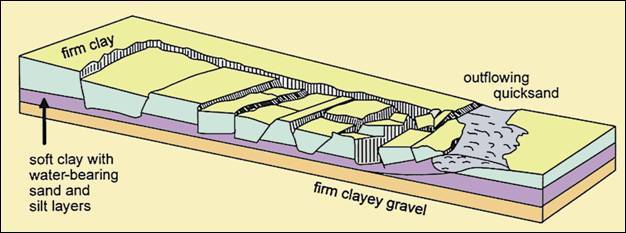What is a lateral spreading phenomenon?
(Extract from Maquaire and Malet, 2006)
Lateral spreading are lateral displacements situated at a certain depth and resting on stable formations. When they occur in coherent rock, whether or not resting on clay deposits or on plastic marl, they may affect a rock massif over considerable thicknesses and are therefore considered as deep-seated landslides. For further information the reader should refer to the following: Jahn, 1964; Bentley and Smalley, 1984.
Soil (debris) lateral spreading
(from Maquaire and Malet, 2006)
We will confine our discussion to shallow lateral spreading occurring in non-cohesive heterogeneous materials such as moraine deposits (debris spreading) or fine clay or sand formations (soil spreading). Fine formations particularly sensitive to this type of movement include varved clays deposited on the banks of the great Pleistocene glaciers in Scandinavia or over smaller areas in the old pro-glacier lakes of the Swiss Alpine border or in the Alpine valleys (Trièves in France; Nieuwenhuis, 1991). Their sensitivity is due to their very low plasticity. Sands may easily liquefy and give rise to this type of movement. Lateral spreading may also develop in coarse and heterogeneous moraine formations (Noverraz et al., 2001).

These movements may occur on very gentle slopes of 5° or less. They display a characteristic morphology (Figure): upstream at the source, a scarp with multiple lobes dominates the displaced part where horsts or rift valleys appear; downstream these shapes are elongated by perpendicular folds in the direction of the movement. The space affected by these movements is often as wide as it is long and they often occur over a very short period of time.

Rock lateral spreading
(From Dikau et al., 1996)
Rock spreading consists of lateral extensions of rock masses either in homogeneous rock or in cohesive rock overlying ductile materials. The latter occur along shears with tensile fractures occurring on overlying coherent rock. Though often decribed as part of complex slope movements, in certain geological conditions they give rise to such peculiar morphological features that they are considered as a separate type of movement.


Schematic block diagram showing lateral spreading in homogeneous (a) and non-homogeneous (b) rocks (from Dikau et al. 1996)




Lateral spreading at Simoncello and Sasso di Simone, northern Apennines, Italy. In the right photos a detail of cracks and trenches on the Sasso di Simone. (from Dikau et al. 1996


Panoramic view (left) and trench details of the lateral spreading at Popeye Village, NW coast of Malta: (photos by M. Soldati)
References:
BENTLEY SP, SMALLEY IJ.. 1984. Landslips in sensitive clays. In Slope Instability, BRUNSDEN D, PRIOR DB. (eds.). Wiley: Chichester; 457-490.
JAHN A. 1964. Slope morphological features resulting from gravitation. Zeitschrift für Geomorphologie, Supplement Band 5: 59-72.
NIEUWENHUIS JD. 1991. Variations in the stability and displacements of a shallow seasonal landslide in varved clays. Balkema: Rotterdam.
NOVERRAZ F., BONNARD C, DUPRAZ H, HUGUENIN L. 2001. Versinclim: comportement passé, présent et futur des grands versants instables en fonction de l’évolution climatique. Hochschulverlag AG: Zürich.
For the other references herein and for knowing sources of didactic material go to 1.3 Selected references.